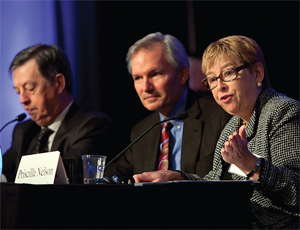Fast-moving environmental, political and workplace trends are boosting civil engineering to a critical new role, even if its practitioners and academics aren’t totally ready, according to speakers and attendees at the annual meeting of the American Society of Civil Engineers (ASCE). The Oct. 29-31 meeting in Kansas City drew nearly 1,000 attendees, including a large contingent of students.

“The world needs the profession to deal with issues that extend beyond civil engineering,” said Priscilla Nelson, a professor and former provost at New Jersey Institute of Technology, Newark. “Too often, we go into a reductionist approach. Civil engineers must declare that this is the profession of the future.”
Len C. Rodman, CEO of Black & Veatch, Overland Park, Kan., noted that sustainability, a key conference theme, still is not high enough on all owners’ priority lists. He noted a company survey on which respondents—several hundred municipal utility leaders—gave sustainability an average importance ranking of 3.6 on a scale of one to five. Greg E. Graves, chairman and CEO of Burns & McDonnell, Kansas City, said, “Our industry must take the lead on technical issues and stand up. Too many organizations are hiring PR firms instead of engineering firms to create the debate.”
Pointing to a predicted shortage of engineers in the future, Graves said, “Shame on us for not challenging our kids. It’s sexier now to be in careers that distribute wealth but don’t create it.”

Design-firm managers discussed emerging trends in workplace flexibility, noting scheduling accommodations can be beneficial, if managed properly. “They must be seen as an investment, not a cost,” said Maria Lehman, transportation systems director for Bergmann Associates, Buffalo, N.Y. Added Lynne Moss, a manager at CDM in Austin, “We don’t view these as benefits or entitlements, just as another way of working.”
ASCE, which has been faulted by some for lobbying efforts that failed to garner a larger share of the $787-billion federal stimulus for infrastructure, is readying members to push for a possible new round of funding, even as competing issues emerge. “We had our 15 minutes of fame. Now the public has moved on to health care and climate change,” said D. Wayne Klotz, outgoing president. “Until civil engineers convince themselves, we will be limited in convincing others that infrastructure is of value to society.”
Blaine D. Leonard, 2010 association president and research program manager for Utah Dept. of Transportation, said ASCE’s expedited release of its 2009 infrastructure “report card” was a key in getting money earmarked for transportation stimulus projects. But, he said, “Will shovel-ready be the right way to go next time? We need to be around the table during planning and policymaking.”
Leonard said ASCE also is mulling whether to elevate discussion of generational issues at next year’s conference in Las Vegas and reinstate more technical content into its annual conferences within the next two years.





Post a comment to this article
Report Abusive Comment